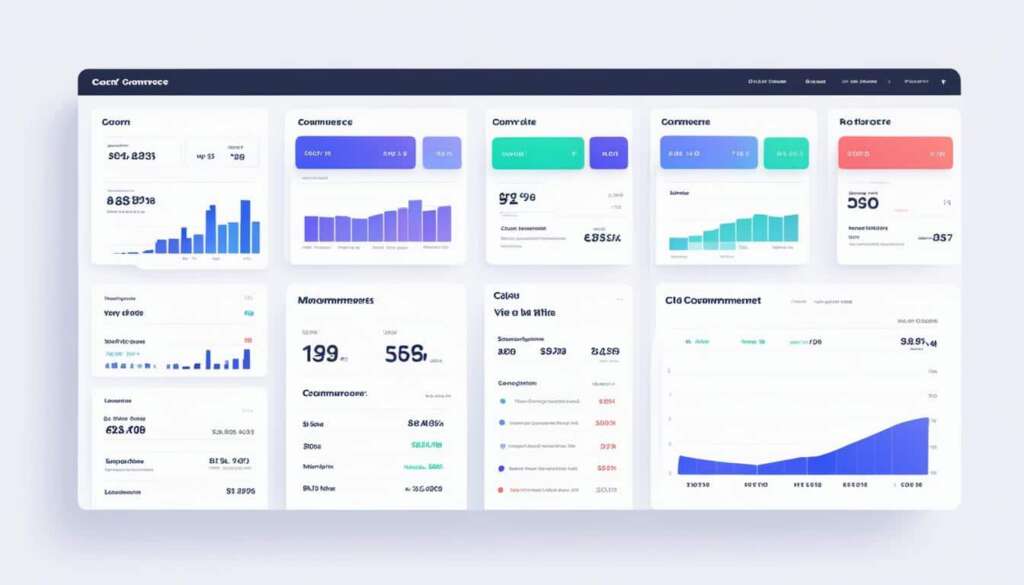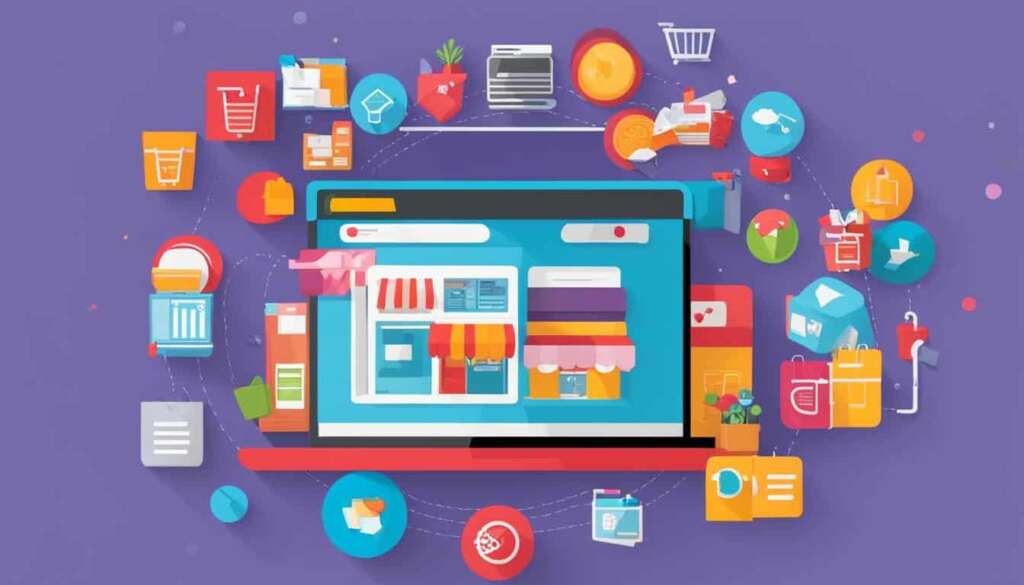Table of Contents
Welcome to the Ultimate Guide to E-commerce Enterprise Growth. In this comprehensive guide, we will explore the strategies, tips, and best practices for driving growth in your online business. Whether you are an established e-commerce enterprise or just starting out in the online marketplace, this guide is designed to help you achieve remarkable success.
Written by renowned experts Ian Hammersley and Mark Hammersley, this guide delves into the key performance indicators that are crucial for e-commerce success. From the add-to-basket rate and website speed to customer recruitment and traffic growth, we will provide actionable advice and models for improving these metrics and driving overall growth in your business.
This guide goes beyond just e-commerce and offers insights that can be applied to any type of business. As the digital landscape continues to evolve, it is essential to stay ahead of the curve and adapt to the ever-changing consumer preferences and needs. By implementing the strategies outlined in this guide, you will be equipped with the tools and knowledge to thrive in the competitive world of e-commerce.
In the following sections, we will cover various facets of e-commerce, including the benefits of e-commerce, current industry trends, different types of e-commerce, and how to start an e-commerce business. We will also delve into e-commerce marketing best practices and provide guidance on choosing the best e-commerce software for your specific needs. Finally, we will conclude with a summary of the key takeaways and the path to e-commerce success.
Benefits of E-commerce
E-commerce offers numerous benefits for both buyers and sellers. Let’s take a closer look at how e-commerce revolutionizes the way we shop and conduct business.
Convenience
One of the main advantages of e-commerce is its convenience. With just a few clicks, buyers can browse through a wide range of products from the comfort of their own homes. No longer do they need to brave long lines or crowded stores. Instead, the products they desire are just a few taps away.
Quicker and Easier Transactions
Thanks to e-commerce, transactions have become faster and simpler. Customers can complete their purchases with ease, without the hassle of physically handling cash or going through complicated payment processes. This streamlined experience enhances customer satisfaction and encourages repeat purchases.
Access to Information for Informed Purchasing Decisions
Buyers can access detailed product information, customer reviews, and ratings, empowering them to make informed purchasing decisions. They can compare prices, read about others’ experiences, and analyze product features, all of which contribute to a well-informed buying process.
Easier Price and Product Comparisons
E-commerce enables buyers to compare prices and products with great ease. Instead of visiting multiple physical stores, they can simply open different tabs on their browsers and compare prices, features, and reviews side by side. This allows them to make the best choice for their needs and budget.
Improved Delivery Processes
With e-commerce, delivery processes have significantly improved. Buyers can enjoy fast and reliable shipping options, including same-day or next-day delivery. They can also track their orders in real-time, ensuring transparency and peace of mind throughout the entire delivery process.
Targeted Communication
E-commerce enables sellers to communicate directly with their customers in a targeted and personalized manner. Through email marketing, social media promotions, and personalized recommendations, sellers can engage with their audience in a more meaningful way, increasing customer loyalty and satisfaction.
“E-commerce has revolutionized the shopping experience, providing convenience, access to information, and improved delivery processes. It has empowered consumers to make informed purchasing decisions and has given businesses expanded reach and control over their selling processes.”
Overall, e-commerce brings a wealth of benefits to both buyers and sellers, transforming the way we shop and conduct business. It provides convenience, enables informed purchasing decisions, and streamlines transactions and delivery processes. Stay tuned for the next section, where we will explore the latest trends in the world of e-commerce.
E-commerce Trends
E-commerce has witnessed remarkable growth in recent years, making significant strides in the retail industry. The United States, as a major player in the e-commerce market, has experienced a steady increase in online sales. By 2024, projections estimate that the U.S. e-commerce sales of physical goods will reach nearly $476.5 billion, reflecting the immense potential and scale of this industry within the country.

However, the growth of e-commerce is not limited to the U.S. alone. Globally, there has been a surge in retail e-commerce sales, with an expected value of over $4.058 trillion by 2020. This unprecedented growth has transformed the way businesses operate and consumers shop. As technology advances and online platforms become more accessible, the e-commerce landscape is continuously evolving, presenting abundant opportunities for businesses to thrive.
The Rapid Growth of Retail E-commerce
| Industry | Significant Growth |
|---|---|
| Jewelry and Watches | Explosive growth in e-commerce sales |
| Furniture | Increasing demand for online purchases |
| Appliances | Rapid growth in online sales |
| Video Games/Accessories | Strong e-commerce presence |
As consumer preferences continue to shift towards online shopping, certain industries, such as jewelry and watches, furniture, appliances, and video games/accessories, have experienced particularly significant growth in terms of retail e-commerce.
This growth can be attributed to various factors, including the convenience of online shopping, the wide range of products available, and the ability to make informed purchasing decisions through detailed product descriptions and customer reviews. Furthermore, the global reach of e-commerce allows businesses to overcome geographical limitations and expand their customer base.
As the e-commerce industry continues to flourish, it is essential for businesses to stay updated with the latest trends and adapt their strategies accordingly. By embracing e-commerce and capitalizing on its potential, businesses can position themselves for long-term success and tap into a global marketplace that offers unparalleled growth opportunities.
Types of E-commerce
E-commerce is a vast domain that encompasses various types of online transactions. Understanding the different types of e-commerce can help businesses tailor their strategies to target the right audience. In this section, we will explore three key types of e-commerce: Business to Business (B2B), Business to Consumer (B2C), and Consumer to Consumer (C2C).
Business to Business (B2B) E-commerce
B2B e-commerce involves the exchange of goods and services between different businesses. This type of e-commerce is commonly used by manufacturers, wholesalers, and distributors to sell their products to other businesses. B2B transactions often involve larger order volumes and complex negotiation processes. B2B platforms such as Alibaba, Alibaba Group Holding Limited, and Amazon Business have gained significant popularity in recent years, providing businesses with a convenient marketplace to connect and conduct transactions.
Business to Consumer (B2C) E-commerce
B2C e-commerce refers to online transactions between businesses and individual consumers. In this model, businesses directly sell their products or services to end consumers through their websites or platforms. B2C e-commerce has revolutionized the retail industry by offering convenience, broader product selections, and competitive pricing. Well-known B2C e-commerce platforms include Amazon, ASOS, and Tesco, enabling consumers to shop for a wide range of products from the comfort of their homes.
Consumer to Consumer (C2C) E-commerce
C2C e-commerce involves transactions between individual consumers, facilitated by online marketplaces. Individuals can buy and sell products directly to one another, often through auction-style listings or classified platforms. Well-established C2C e-commerce platforms like eBay and Craigslist provide users with a platform to connect and engage in buying and selling activities. C2C e-commerce has opened up opportunities for individuals to monetize their unused or unwanted items, fostering a sustainable cycle of reuse and recycling.
Understanding these different types of e-commerce enables businesses to identify the most suitable approach for their target market. Choosing the right e-commerce model can unlock new growth opportunities and enhance customer engagement.
E-commerce Types Comparison
| Category | B2B E-commerce | B2C E-commerce | C2C E-commerce |
|---|---|---|---|
| Definition | Exchange of goods and services between businesses | Selling products or services directly to consumers | Transactions between individual consumers |
| Transaction Volume | Large volume, often involving bulk orders | Variable volume, individual consumer orders | Variable volume, individual consumer orders |
| Target Audience | Businesses and professionals | Individual consumers | Individual consumers |
| Examples | Alibaba, Amazon Business | Amazon, ASOS, Tesco | eBay, Craigslist |
Each type of e-commerce has its unique characteristics and target audience. Businesses can leverage these different models to reach the right customers and maximize their online sales potential.
How to Start an E-commerce Business
Starting an e-commerce business involves several key steps that are critical for success. To begin, it is crucial to evaluate the audience and determine the demand for your product. This can be done through niche research and careful analysis of the market. Understanding your target market will help you identify gaps in the market and opportunities for growth.
Once you have conducted thorough research on the competition, it is time to choose a business model and sales strategy that aligns with your goals and target audience. This will help you differentiate yourself from competitors and attract customers.
Next, you need to give your business an identity by selecting a unique name and registering it. Establishing a brand and designing a logo will help you create a memorable and professional image in the minds of your customers. This branding should be consistent across all your online platforms.
After establishing your brand, it’s time to create your product. Determine the manufacturing costs and processes involved and ensure that the quality meets the expectations of your target customers. Set up efficient shipping and fulfillment processes to ensure smooth delivery of products to your customers.
With your product ready, it’s time to establish your online presence. Purchase a domain name that reflects your brand and create a visually appealing and user-friendly website. The website should be optimized for search engines and provide a seamless purchasing experience for customers.
Developing a marketing plan is crucial for driving traffic to your online store. Use strategies such as search engine optimization (SEO), social media marketing, email marketing, and content marketing to attract and engage potential customers. Utilize analytics tools to monitor the effectiveness of your marketing efforts and make necessary adjustments.
Finally, secure social media profiles to further promote your brand and engage with customers. Building a strong social media presence will help you connect with your target audience and build brand loyalty.
By following these steps and conducting careful niche research and competition analysis, you can lay a strong foundation for your e-commerce business and increase your chances of success.

E-commerce Marketing Best Practices
Effective marketing plays a crucial role in the success of an e-commerce business. By implementing best practices, businesses can enhance their marketing strategies and drive growth. Here are some key practices to consider:
Social Media Ads
Social media platforms, such as Facebook, provide excellent opportunities for targeted advertising. Testing and optimizing social media ads can help businesses reach their target audience, increase brand visibility, and drive traffic to their e-commerce website. Utilizing the powerful targeting capabilities of social media platforms allows businesses to connect with potential customers who are more likely to convert into buyers.
Email Marketing
Collecting email addresses from customers and prospects enables businesses to establish a direct line of communication. With email marketing, businesses can nurture relationships, build trust, and deliver personalized promotions and offers to subscribers. By segmenting email lists and tailoring messages based on individual preferences and behaviors, businesses can increase engagement and drive sales.
Personalization
Personalization is a key driver of customer satisfaction and loyalty in e-commerce. By using data-driven insights, businesses can personalize product recommendations, offers, and messaging to cater to individual customer preferences. Customized experiences create a sense of personal touch and improve the likelihood of conversion and repeat purchases.
Gathering Feedback
Feedback from customers is invaluable for improving products, services, and overall customer experience. Implementing surveys and feedback forms on the e-commerce website allows businesses to collect valuable insights and identify areas for improvement. By addressing customer feedback and making necessary adjustments, businesses can enhance customer satisfaction and loyalty.
Choosing the Right E-commerce Software
Having the right e-commerce software is essential for implementing effective marketing campaigns. The chosen software should align with the business’s needs and goals, offering features such as seamless integration with marketing tools, advanced analytics and reporting capabilities, and easy customization options. Investing in reliable e-commerce software sets the foundation for successful marketing strategies.
By incorporating these e-commerce marketing best practices, businesses can maximize their marketing efforts, attract more customers, and drive sustainable growth in the competitive e-commerce landscape.
How to Choose the Best E-commerce Software
When it comes to selecting the ideal e-commerce software for your business, there are several crucial factors to consider. These include themes and customization options, expert support, flexible payment solutions, multilingual capabilities, and best practices for website optimization. By carefully evaluating these elements, you can ensure that the e-commerce software you choose aligns with your specific requirements and sets your business up for success.
Themes and Customization
One important aspect of e-commerce software is the availability of themes and customization features. These allow you to personalize your online store and create a unique brand identity. The ability to customize your site’s design and layout is essential for ensuring that it reflects your brand and appeals to your target audience.
Expert Support
Expert support is another crucial factor to consider. Having access to knowledgeable support staff who can assist you with technical issues, provide guidance on optimizing your e-commerce site, and address any concerns or questions that arise is invaluable. Look for e-commerce software providers that offer responsive and reliable support services, ideally with 24/7 availability.
Flexible Payment Options
The ability to offer customers a variety of payment options is essential for successful e-commerce. Look for software that supports multiple payment gateways and payment methods to ensure that your customers can make purchases conveniently and securely. Popular payment options to consider include credit/debit cards, digital wallets like PayPal, and alternative payment methods such as Klarna or Apple Pay.
Multiple Language Abilities
In today’s global marketplace, catering to a diverse audience is essential. If you have international customers or plan to expand into new markets, it’s important to choose e-commerce software that supports multiple languages. This feature allows you to provide a localized experience, including translated product descriptions, customer support in different languages, and currency conversion.
Best Practices for Website Optimization
Website optimization plays a crucial role in driving traffic and conversions. When choosing e-commerce software, consider its built-in optimization features, such as search engine optimization (SEO) tools and the ability to create mobile-friendly and responsive designs. The software should empower you to optimize your website’s speed, performance, and user experience, ultimately enhancing your site’s visibility and ranking in search engine results.
To summarize, selecting the best e-commerce software requires careful consideration of factors such as themes and customization options, expert support, flexible payment solutions, multilingual capabilities, and website optimization features. By choosing software that aligns with your business’s specific needs, you can create an exceptional online shopping experience for your customers and set your business up for long-term success.
| Factors to Consider | Importance |
|---|---|
| Themes and Customization | High |
| Expert Support | High |
| Flexible Payment Options | Medium |
| Multiple Language Abilities | Medium |
| Best Practices for Website Optimization | High |
Conclusion
By implementing the strategies, tips, and best practices outlined in “The Ultimate Guide to E-commerce Success: Strategies, Tips, and Best Practices for a Thriving Online Business,” businesses can build a solid foundation and achieve exceptional growth in the fiercely competitive world of e-commerce. Continuous adaptation and innovation are crucial to staying ahead of the curve and capitalizing on emerging industry trends. It is imperative for online businesses to remain up-to-date with the latest technological advancements and consumer preferences to ensure long-term success.
Thriving in e-commerce requires a deep understanding of customer needs and preferences. By leveraging data analytics and consumer insights, businesses can make informed decisions that drive online business growth. Personalized marketing, tailored product offerings, and exceptional customer experiences all contribute to customer loyalty and satisfaction, leading to increased sales and sustained success.
Furthermore, successful e-commerce ventures prioritize seamless user experiences, from intuitive website navigation and mobile responsiveness to secure payment gateways and efficient order fulfillment. By investing in the right e-commerce software and optimizing website performance, businesses can enhance their online presence and attract a wider audience.
As the e-commerce landscape continues to evolve, it is vital for businesses to embrace change, seek opportunities for growth, and remain adaptable in the face of challenges. With a clear understanding of their target market, a strong digital strategy, and a commitment to providing exceptional customer experiences, online businesses can thrive and achieve significant e-commerce success.
FAQ
What is “The Ultimate Guide to E-commerce Growth” about?
“The Ultimate Guide to E-commerce Growth” is a highly recommended book for e-commerce website owners looking to drive growth in their online businesses. It focuses on 7 key performance indicators that are crucial for success in e-commerce and provides actionable advice and models for improving these indicators.
What are the benefits of e-commerce?
E-commerce offers several benefits for both buyers and sellers. For buyers, it provides convenience, quicker and easier transactions, access to information for informed purchasing decisions, easier price and product comparisons, improved delivery processes, and targeted communication. For sellers, it reduces overhead costs, allows for 24/7 sales, expands geographical reach, provides more control over the selling process, enhances visibility through SEO, and offers better control over personnel costs and inventory management.
What are the trends in e-commerce growth?
E-commerce has been experiencing significant growth in recent years. In the U.S., e-commerce sales have been steadily increasing, with estimates projecting online retail sales of physical goods to reach nearly $476.5 billion by 2024. Globally, retail e-commerce sales are expected to exceed $4.058 trillion by 2020. Certain industries, such as jewelry and watches, furniture, appliances, and video games/accessories, have seen rapid growth in terms of retail e-commerce.
What are the different types of e-commerce?
E-commerce can be classified into three types: Business to Business (B2B), Business to Consumer (B2C), and Consumer to Consumer (C2C). In B2B e-commerce, goods and services are sold from one company to another. B2C e-commerce involves businesses selling directly to customers, while C2C e-commerce refers to transactions between consumers, typically through online marketplaces like Craigslist, eBay, and Amazon.
What are the key steps to start an e-commerce business?
Starting an e-commerce business involves several key steps. These include evaluating the audience and demand for a product, conducting thorough research on the competition, choosing a business model and sales strategy, naming and registering the business, establishing branding and designing a logo, creating the product, determining manufacturing costs and processes, setting up shipping and fulfillment processes, buying a domain name and creating a website, developing a marketing plan, and securing social media profiles. Once these steps are complete, the online store can be launched.
What are some best practices for e-commerce marketing?
Effective marketing is crucial for the success of an e-commerce business. Some best practices include testing social media ads on platforms like Facebook, collecting email addresses for future communication and offering personalized promotions, using personalization tactics to tailor offers and messaging to individual customers, gathering feedback through surveys, and choosing the right e-commerce software that meets the business’s needs and goals.
How should I choose the best e-commerce software?
When choosing e-commerce software, it is important to consider factors such as themes and customization abilities that allow for personalization, domain name customization to create a unique brand identity, expert and 24/7 support, flexible payment options, multiple language abilities to cater to a global audience, and best practices for website optimization. Careful consideration of these factors will ensure the best e-commerce software is selected to meet the business’s specific requirements.
How can I achieve success in the e-commerce industry?
By following the strategies, tips, and best practices outlined in “The Ultimate Guide to E-commerce Growth,” businesses can establish a strong foundation and achieve remarkable growth in the competitive world of e-commerce. Continuous adaptation and innovation, staying up-to-date with industry trends, and focusing on consumer preferences and needs are key to long-term success in the e-commerce industry.













